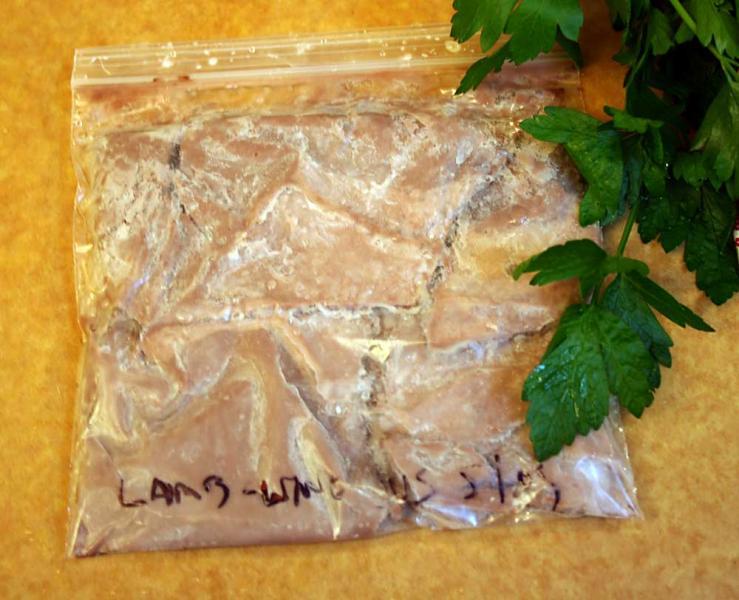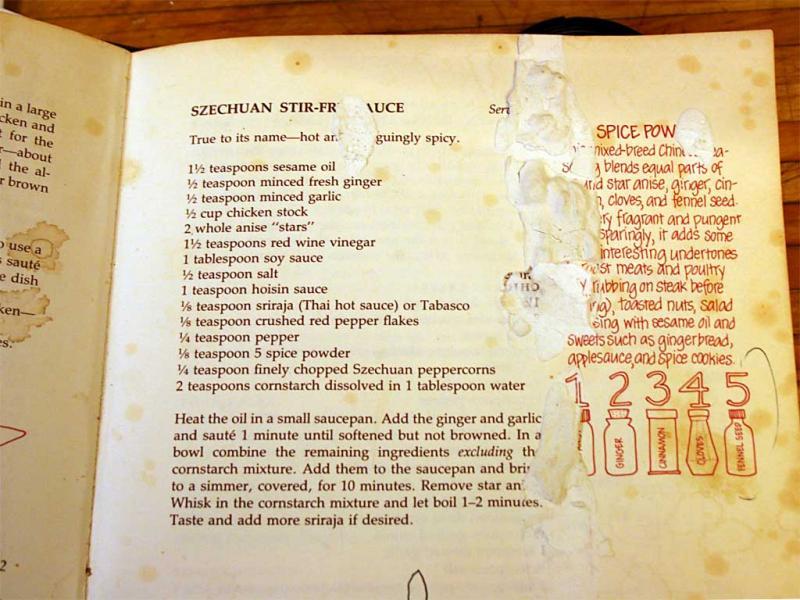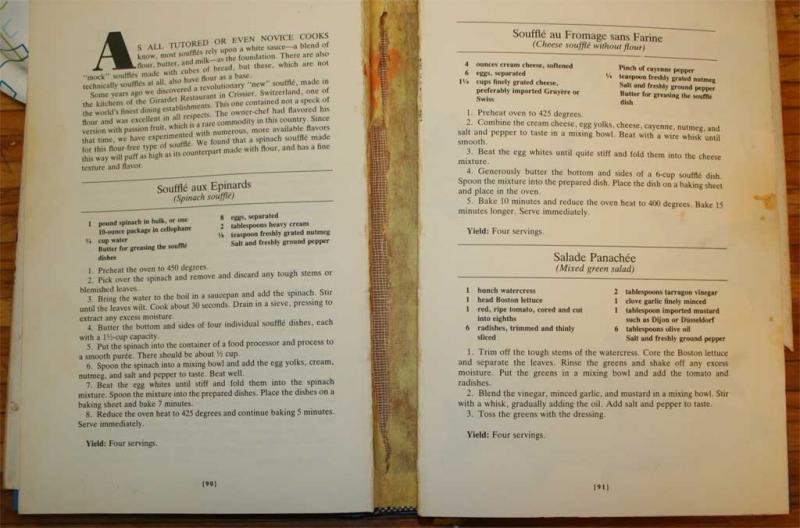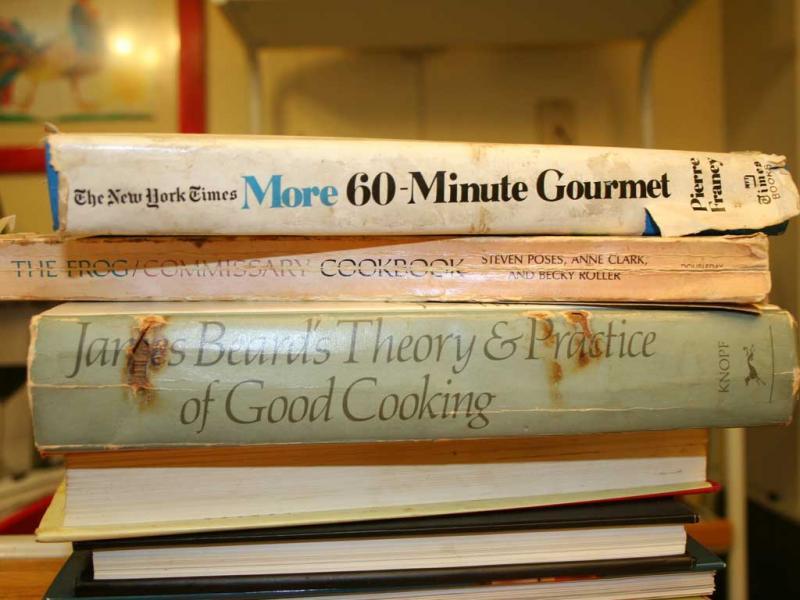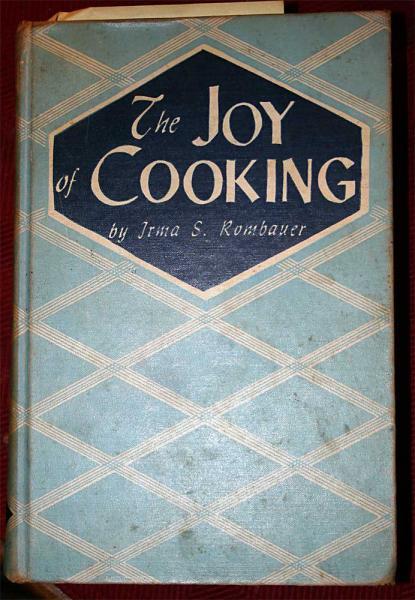-
Posts
8,089 -
Joined
-
Last visited
Content Type
Profiles
Forums
Store
Help Articles
Everything posted by Dave the Cook
-
What fun is that?
-
The carryover on the roasted leg of lamb was a bit more than I had anticipated. I recalled that I had used the last of the lamb stock for a rack about a month ago -- and I'm between batches of chicken and beef stock -- so I'm not sure what I was expecting to find when I went rummaging, except that I needed something from which I could make a sauce of sorts. My freezer is a jumble of charcuterie, half-packages of hamburger buns and random frozen vegetables, not to mention several frosted-over plastic bags filled with food (I assume) of indeterminate origin. I was about to sacrifice a cup of pork stock when I came across this: I'd even labeled it: lamb-wine jus. And I'd dated it! And then forgotten about it. Of course, I'm often a disorganized slob. But I doubt that I'm the only one who doesn't know what languishes in the frosty depths of our side-by-sides, chests and front-load uprights. What did you discover today -- a gem? A mushy disaster? Log them here (extra points for well-rimed photographs).
-

The cookbooks that made you the cook you are
Dave the Cook replied to a topic in Cookbooks & References
Pictures! This topic needs pictures! I'm also a student of the Frog-Commissary school, for all the reasons previously cited. As you can see, it was my standby during a kitchen renovation: . . . and a Franey disciple, through (almost literally) both 60-Minute Gourmet books: I'd say that at least half of my day-to-day cooking still references Pierre's work. Here's a shot of the limbered spines of those two, along with a third influence, James Beard's Theory & Practice: When, through a series of coincidences, I found myself cooking on a restaurant line, my chef lent me his copy of T&P so that I could fill in some of my knowledge gaps; eventually I got this copy of my own. Then there's the first cookbook I ever cracked, somewhere around 1965 (surprisingly, it's in the best shape of all), the 1946 edition of Joy: It was the only cookbook I had (technically, it's my Mom's; she got it from her mother-in-law as a wedding present) for probably six or seven years, until my parents gave me the New York Times Cookbook. -
Bookbinders closed earlier this year.
-
Comparing the two lines, it looks like the main trade-offs are: Whirlpool is a little cheaper, but offers the "NSF Sani Rinse" option. KitchenAid has stainless tubs and food grinders. If it was my money, I'd go for the KUDS30IVSS with the ProScrub option. (We have a 25-year-old Kitchen Aid that's still going strong.) It might worth jumping up to the KUDE45CVSS -- stainless interior, food grinder and Sani Rinse, and only $100 more than the KUDS40CVSS. If you go the other direction, keep in mind that Whirlpool makes a good part of the Kenmore line, so as long as you compare like models, you can shop on price between the two. Also, for anything that Sears sells, it's worth checking their outlets -- scratch-and-dents and discontinued models that still carry full warranties, at sometimes ridiculous prices.
-
These folks, who should know, say the yield is about 25%.
-
At one time, I had a similar stash of ICG. But now it's gone. Hence my inquiry -- and anticipation.
-
I've considered that. "Sweet" is not an adjective I'd use to describe the effect, though that might not be relevant.
-
Although it's nearly as much trouble as making macaroni and cheese itself, a great way to deal with leftover m&c (especially if it's on the dry side) is to slice it, bathe it in egg and roll in panko. Deep fry until the bread flakes are, you know, golden brown; serve with pepper sauce. Speaking of pepper sauce, I prefer cayenne for anything that cooks for prolonged periods (depending on how you make your m&c, it may or may not qualify). In my experience, cooking pepper sauces for more than about 20 minutes dramatically reduces their effectiveness.
-
I won't say it's impossible, but I'm pretty sure that hydrogenation (of food-grade oils, anyway) is done in a vacuum by bubbling hydrogen (in the form of steam) through the liquid. That's an unlikely and nearly uncontrollable operation to conduct on a stovetop.
-
The other night, I was lucky enough to be treated to dinner at Serpas here in Atlanta. The meal had several highlights, but three days later, what I best remember is a potato. It was a red, cut in half and supporting two crossed trout filets. By the traditional measure, it was way overdone -- I'd guess a good fifteen minutes past the usual "stick a fork in it" guideline. How it maintained its structural integrity I'm not sure, but "overcooking" transformed an ordinary starch into something sublime: it was creamy and earthy in a way that boiled or steamed potatoes almost never are. The point is that sometimes things aren't necessarily done when the typical conditions are reached. Pork shoulder, for another example, benefits from continued heat long after it's reached 160F (or even 175F or 180). Baking potatoes will improve if left in the oven for up to 30 minutes past the hour that most cookbooks will tell you it takes to reach the point of gentle resistance. The former is caused by the collagen stall; I'm not sure what accounts for the latter, and I discovered it through poor dinner-prep timing. I'm sure these aren't the only examples. Enlighten me.
-
Those who have sampled the Smith & Cross: how does it compare to Inner Circle green?
-
Well, they are/were both in Atlanta, which certainly narrows the world down some. They've worked together on and off for at least three years. Eli was sort of the "keeper of the chemicals" when Blais was the executive chef at One.Midtown Kitchen.
-

Practical chicken preparation for the professional kitchen
Dave the Cook replied to a topic in Cooking
Good suggestions so far. I'd add: Braised thighs or leg quarters. You can cook them all the way through and they'll keep for several days. Stick them in the oven to warm the meat and sauce, and under the salamander to crisp the skin.Cornish game hen halves. They cook quickly and make a nice presentation and portion size. Since they almost always come frozen, you have better control of your inventory. -
Capresso is hardly alone in clearing out inventory of discontinued product; many manufacturers follow this practice. Regardless, the MT500 is a very good coffeemaker, and this news actually provides another good reason (along with the price) to snap one up, given Capresso's reputation for poor new-product introductions.
-
I guess they don't do many egg or cream drinks! It really isn't possible to clean cream with just hot water. Tins and/or glassware that have had egg in them need to be cleaned with detergent and warm or cool water. Just hot water won't cut it, they'll just continue to smell of egg. Good point. There's usually something dairy-based on the menu. I guess I'll just have to stop by and have a few drinks -- for research purposes only, of course.
-
I'm surprised you need anything but your hands. Most rotisserie chickens fall apart with a stern glance. This is a good, though probably minor, point -- especially if you're going to use the herbs right away. But plucking herbs, like hand-tearing lettuce, causes the plant to separate at cell boundaries, resulting in less trauma to the plant, and slower oxidation at the separated edge. Check out the link Chris Amirault posted above. The Chicago Cutlery shears (I have two pair) have symmetrical handles, so they're fine for righties or lefties (IIRC, Mr. Amirault is one of the latter). A friend of mine uses scissors to snip the fat edges of bacon strips before frying -- keeps them from shriveling up.
-
I know of one very fine bar that keeps dishwashers around just for the health inspector. All glasses and stainless barware are washed by hand with hot water only, then polished with linen.
-
"Take With Food" has been selected for inclusion in the anthology Best Food Writing 2009. Congratulations, Steven! This is the third year in a row that the Daily Gullet has placed articles in BFW, and the second time in three years for multiple inclusions. Read the official announcement here.
-
"Eggs Enough and Time" has been selected for inclusion in the anthology Best Food Writing 2009. Congratulations, Maggie! This is the third year in a row that the Daily Gullet has placed articles in BFW, and the second time in three years for multiple inclusions. Read the official announcement here.
-
For the third year in a row, Daily Gullet articles have been selected for inclusion in the annual anthology Best Food Writing. The 2009 edition, due out in early November, will feature Steven Shaw's (Fat Guy) gustatory reminiscence Take with Food and Margaret McArthur's (maggiethecat) soft-boiled take on hen-fruit cookery, Eggs Enough and Time. Pre-order Best Food Writing 2009 here. Previous Best Food Writing selections: 2008 : Janet Zimmerman's (JAZ) I Melt with You. 2007 : Ivy Knight's (ivy) The Greatest Restaurant on Earth and The Frying of Latke 49 by Steven Shaw (Fat Guy) . Please join us in congratulating Steven and Maggie with a PM.
-
Well, yes, an interesting experiment. The thing is, tinctures by definition are alcohol-based. And there's the rub: alcohol is a great solvent for many flavor molecules that water doesn't handle. If one is really trying to do without alcohol, I think Aloha Steve's implicit conclusion -- that a substitution can lead to something different but still very good -- is an admirable and less-frustrating path to follow.
-
The Tuesday Morning flyer in my mail today says they have the Capresso MT500 for sale for $100. This is an excellent coffeemaker at a jaw-dropping price.
-
This doesn't directly answer your question, but what I often do is buy miniatures. A few weeks back, I had to make an olive oil cake that included amaretto. If I'd bought a 750 ml bottle, 715 milliliters would have still been in it when the world came to an end. A two-buck miniature (50 ml/1.7 oz) solved the problem.
-
Given the way Silpat words their instructions, I imagine they're less worried about product liability than trying to ensure long-term customer satisfaction across an array of customer types, including commercial kitchens, where conditions can be a lot rougher than in homes. Still, I've seen a lot of Silpat pieces in regular use in restaurant kitchens. It wouldn't surprise me if my Silpat eventually deteriorated after years of automatic dishwashing -- and being rolled up inside a paper towel core. I wouldn't complain to Silpat, but if I did they'd just say, "Dude, we told you not to do that." They'd be right. And I'd buy another one and "mistreat" it, too. But enough about Silpats. How do people treat their PTFE (aka Teflon) cookware? The only reason not to put it in the dishwasher is aesthetic: the anodized aluminum that usually comprises the body of the pan starts to look chalky and etched. The part you cook on -- the non-stick coating -- couldn't care less.


